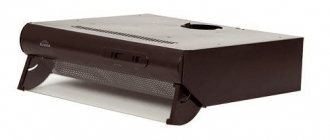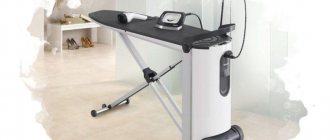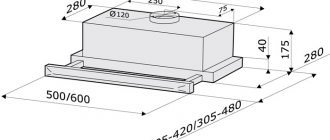Useful properties of the hood
Many people believe that purchasing a range hood is pointless. Let's figure out why you need a hood in the kitchen at all.
During the cooking process, not the most beneficial fumes are often released. This applies to a greater extent to gas stoves, since their operation produces carbon dioxide. But electric stoves also emit a lot of contaminants, most of all grease. These contaminants need to be removed as quickly as possible.
During the cooking process, another problem appears - odors. Many foods have an unpleasant odor when cooked. For example, many people don’t like the smell of fish. In addition, it is very caustic and difficult to get rid of.
Walls, ceilings, and furniture deteriorate greatly due to settled fat. You can wash the furniture and ceiling, but what to do with the walls and ceiling. Due to dirt and fumes, you will make repairs much more often, because the wallpaper will turn yellow and lose its appearance.
To avoid such problems, you need to purchase a hood.
How to calculate the required power for a hood
When they talk about how to choose the power of a kitchen hood, they mean the quality of its fans. The performance of the device directly depends on the power.
The air in the kitchen should be completely renewed 10-12 times per hour, i.e. approximately every 5 minutes. Accordingly, a kitchen hood should provide a performance that exceeds the volume of the kitchen by 10-12 times. The volume of the kitchen can be calculated using the simple formula “multiply the area by the height of the ceiling”, and then multiply the resulting number by 10 or 12. But, in addition to the nominal volume of air with which the hood must work, it is important to take into account possible losses. For recirculating hoods they can be up to 40%; due to the peculiarities of the filters, for hoods with a tap this value is within 20%.
Most hoods have several operating modes. For them, manufacturers can indicate not only the maximum power consumption, but also its intermediate values or average power consumption.
Types of hoods
Let's figure out what types of hoods exist. This will help you understand which hood is right for you.
Classic hood
This hood is small in size and should not be placed above the stove. It can be placed openly or hidden in a closet. The classic hood is considered the most affordable due to its low cost.
Built-in hood in the kitchen
The main advantage of a built-in hood in the kitchen is that it is not visible and, accordingly, it does not spoil the view. This hood is installed directly in the cabinet above the stove. A built-in hood is the best hood for a small kitchen where every centimeter is important.
Read: Furniture. Selection of kitchen units
Dome hood
The hood is installed in a hanging position above the stove. There are various forms of dome hoods. In addition, the dome hood can be either straight or inclined. Inclined hoods are currently very popular.
Advantages of an inclined hood:
- Silence
- Compactness
- Touch control
- Easy assembly
Having purchased such a hood, you will not be faced with the question “How to install a hood”, because... you can easily do this yourself.
Retractable hood
The second name for this hood is telescopic. Using a special mechanism, it extends above the stove. They take up little space and are not connected to the air duct.
Island hood
This hood is attached to the ceiling and directly above the stove. If the ceiling is high, then you need to buy a more powerful hood. This hood is well suited for private houses with high ceilings.
Should you install the hood yourself or call a professional?
If you have the time and desire to install the hood yourself, then most likely you can do it. There is nothing complicated about this and all the necessary information will be listed below. For those who find it easier to perceive information visually, we can also recommend finding a video of the hood installation on the Internet.
However, you won’t be able to do it not only without spending your time, but also without some tools. And, if you don’t have them yet and there’s nowhere to borrow them, these are additional costs:
- Hammer or drill. If the wall to which you need to attach the hood and air ducts is wooden or made of plasterboard, an inexpensive drill is sufficient. If the wall is brick or concrete, you need a hammer drill. Because even a drill with an impact mechanism may not cope.
- A hacksaw for metal - if you plan to use an air duct made of plastic pipes.
- Jigsaw - if the hood will be built into a part of the kitchen cabinet installed above the stove.
- A set of screwdrivers, or one universal one with replaceable bits.
- Every little thing that can be replaced with improvised means: ruler, tape measure, level, pencil, paper tape.
Read here - Check valve for ventilation: main types, principle of operation and tips for choosing parameters (100 photos)
On what principle do hoods work?
In addition to the question of what types of kitchen hoods there are, it is necessary to at least slightly understand the principles of their operation, since this factor is also of great importance.
Here we can distinguish two operating principles: recuperative and conventional. Well, with the second method of air purification everything is clear. The hood draws in the vapors that arise during cooking, and the air, which does not always have pleasant odors, passes through the filters and is directly discharged into the ventilation system.
But devices operating on the basis of recovery, passing air through their filtration system, return it back, already cleared of excess vapors, grease, and odor.
Here it is worth considering in more detail the technical characteristics of kitchen hoods. For example, models working with air recovery are the most expensive. They are also expensive to maintain, despite the fact that such models have metal filters made of aluminum built in to clean the air from contaminants.
In order to rid the kitchen of unpleasant odors, it is necessary to have carbon filters in such devices. These elements will have to be changed periodically, as they wear out quickly. The effectiveness of eliminating unpleasant and specific odors in the kitchen will depend primarily on the quality of these elements.
But the big advantage of such devices is that they return the air passed through the filtration system. They also return part of the heat to the room, while dome hoods that have access to the ventilation shaft take in exhaust air with heat, without returning anything back.
Photo of kitchen hoods
Read here Country kitchen: style features and 103 photos of simple design
Did you like the article? Share 
Hanging hoods
Hanging devices are compact in size and are installed directly above the stove. Their operating system is based on the use of filters, so you can safely hang kitchen cabinets above them without worrying about their appearance. As a rule, in such models most often the simplest cleaning filters made of synthetic material (acrylic) are installed. A significant disadvantage of these filters is the need to replace them frequently (usually every three months).
In order to save yourself from constantly buying and replacing a filter, you can purchase a model that has a metal filter. As it absorbs grease, it will also become dirty, but you can simply wash it periodically with regular dishwashing detergent diluted in a little warm water.
These types of kitchen hoods today are among the least efficient in terms of performance, since they have fairly low power.
Types of hoods
The hood is not something new, outlandish, or unusual for us, because they were quite common decades ago.
Now this has reached a new level, which is noticeable in the photo of kitchen hoods of different variations. Now they differ not only in appearance, but also in technical filling and details.
There are different hoods on the market, and therefore you must understand the differences between them in order to buy exactly what is suitable for your case.
Before thinking about where to buy a kitchen hood, let's prepare for what we might see in the store. They can be of two types - active and passive. Let's start with the second option.
Passive hood
A passive hood serves as a guide for the air space above the stove. Such a hood needs to be connected to a ventilation system, because due to the pressure inside it, air moves.
This option is naturally cheaper, but the performance leaves much to be desired, and you need to install a channel for air removal.
Active hood
The second type of hoods looks much more interesting, especially in modern realities. An active or forced hood operates from electricity and forcibly draws in air, then passing it through filters.
Usually these are circulating, because the air remains in the room and does not go outside, as is the case with the passive option.
With a small kitchen area, such a 60 cm diameter hood is quite sufficient to cope with all possible loads.
Nowadays it is quite difficult to find passive hoods, because they were installed a long time ago - now everyone usually buys active hoods, and only their connection model is different - flow-through or connected to ventilation.
Installation Rules
The installation requirements for the hood are the same for all types of models. Since the device is an electrical device that collects grease and moisture, a breakdown of current may occur through the housing of the equipment. To protect yourself during installation, you must properly ground the hood.
Typically, modern houses are equipped with a grounding loop and there should be no problems in this regard: you can insert the plug into the socket and the device is ready for use. If such a circuit does not exist, it is necessary to make it. Under no circumstances should you connect the grounding wire to pipes or radiators, as not only family members, but also neighbors may be injured if they receive an electric discharge through the risers.
In order to ground the device, a three-core wire with a cross-section of 2.5 square meters should be connected. mm to the electrical panel. Then find the pipe (solid neutral) from which the bundle of wires comes out, and connect your wire to it. Its end must be stripped.
Before purchasing a hood, you need to measure the cooking surface of the kitchen stove - length and width. For the device, these dimensions should be larger or, in extreme cases, the same. A hood with a smaller area will not cope with high-quality removal of polluted air.
Another rule that you need to remember when installing a hood is maintaining the distance from the surface of the stove to the appliance. The height above electric and induction stoves should be 65-75 cm, above gas stoves - at least 80 cm. If these parameters are not taken into account, inconvenience in working at the stove or fire hazards may arise due to overheating of the device.
We recommend that you read: Do-it-yourself natural ventilation system in a private house
The device must be fastened to the wall firmly and reliably, otherwise the device may break and injure one of the family members. Therefore, when covering the walls with plasterboard during repairs, you need to strengthen the place and place wooden blocks in the intended area for attaching the hood.











